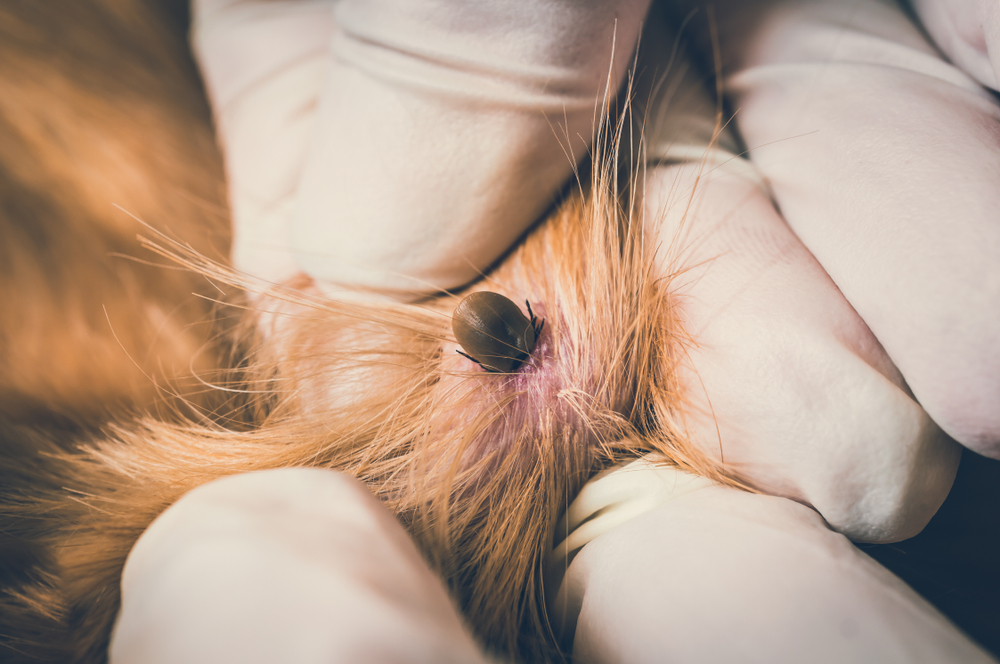As tick populations spread, Canadian pets and people are more at risk of contracting a serious tick-borne illness. Recent data shows that diseases that were previously rare in Canada are becoming more common, as the black-legged tick and other species expand their habitat.
Step 1: Safely remove the tick from your pet
If you discover a tiny arachnid making its way through your pet’s fur, you need to dispose of the creature before it latches on, which you can do with a wad of paper towel and a jar of rubbing alcohol. However, a tick that is attached to your pet must be removed as safely and quickly as possible. Follow these steps to remove a tick safely and effectively:
- Correctly identify the tick — If you find what you think is a tick on your pet, ensure you have truly found a tick and not a skin tag, adenoma, or nipple. Tick larvae have six legs and are incredibly tiny, while nymphs and adults have eight legs and can range in size from a pinhead to a pencil eraser. Most ticks are some brown color variation, although engorged ticks typically turn gray.
- Grasp the tick — Using fine-tipped tweezers or a tick-removal tool, grasp the tick’s head as close to your pet’s skin as possible. Do not grab the body, because that can cause the tick to inject pathogens into your pet.
- Remove the tick — Steadily and slowly pull straight back and remove the tick. Avoid twisting or jerking motions, which may leave the tick’s head behind.
- Dispose of the tick — Kill the removed tick in a small container of rubbing alcohol.
- Clean the bite site — Wash the tick attachment area with an antiseptic cleanser to reduce the risk of a skin infection.
Step 2: Monitor your pet for tick-borne illnesses
Ticks generally must be attached for at least several hours, if not days, before they transmit disease to your pet—for example, the bacteria responsible for Lyme disease take about 48 hours to be passed to your pet. But, prompt tick removal is still important to prevent infection.
Some of the most common tick-borne illnesses your pet can contract include Lyme disease, babesiosis, anaplasmosis, and ehrlichiosis, which can cause:
- Fever
- Lethargy
- Loss of appetite
- Lameness
- Joint pain
- Swollen lymph nodes
- Abnormal bruising or bleeding
While tick-borne illnesses can cause a range of clinical signs, only 5% to 10% of dogs infected with Lyme disease will develop clinical signs, and they may take months to become apparent. So, if your pet has been bitten by a tick, keep in mind that they may not develop problems until much later and should be monitored accordingly.
Step 3: Prevent future tick infestations on your pet

After removing a tick from your four-legged friend, you certainly never want to repeat the experience. The following precautions can help keep your pet safe from future tick infestations:
- Use a tick preventive — Year-round tick prevention is critical for protecting your pet from parasites. Topical applications or oral chews or tablets are highly effective at keeping fleas, ticks, and other parasites off your pet.
- Discourage ticks from your yard — Ticks thrive in tall grasses, wooded areas, and thick brush, so keep ticks out of your pet’s home turf by mowing the lawn short, removing leaf litter, and trimming overgrown vegetation.
- Avoid tick-infested areas — When walking your pet, avoid areas where ticks like to hang out and wait for their next meal. Ticks “quest” for a host, meaning they climb up a tall plant stalk, stick their legs out, and hitch a ride on the next unsuspecting warm body who walks by. Stay in the middle of paths through wooded areas, walk on short grass, and avoid areas where fields meet trimmed yards.
- Consider vaccination — Lyme disease vaccination may be an appropriate choice for your dog, depending on their exposure risk and lifestyle.
- Check your pet for ticks regularly — Tick preventives typically work by killing a tick after biting your pet, so you still need to check your furry pal for parasites. Pay close attention to areas ticks prefer, including under your pet’s collar, in and around their ears, around their eyelids, between their toes, under their tail, and between their legs.
Protect your pet and your family from the threat of tick-borne illnesses by administering a year-round tick preventive. Contact our Animal Hospital of Stoney Creek team to discuss the best tick prevention product for your furry pal.








Leave A Comment